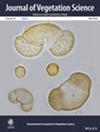Shrubs as Nurse Species for Plant Communities in Arid Environments: A Case Study From Socotra Island (Yemen)
Abstract
Question
Plant–plant facilitation is a critical ecological mechanism in arid environments, influencing biodiversity and ecosystem resilience globally. Shrubs often serve as nurse species, enhancing tree regeneration and sheltering plant communities, particularly in overgrazed or degraded habitats. In this study, we examine the role of shrubs as nurse species in the Socotra Archipelago (Yemen), a biodiversity hotspot in which several endemic tree species, including the iconic frankincense (Boswellia spp.), myrrh (Commiphora spp.), and Socotran dragon's blood (Dracaena cinnabari) trees, are threatened. This is largely due to a lack of natural regeneration caused by the combined effects of overgrazing by goats, sheep, and climatic events such as extreme droughts and cyclones. To aid conservation of threatened trees in arid regions, nature-based solutions are urgently needed to help tree regeneration. Effective nurse plants have this potential, particularly in arid environments. We therefore examined the role of thorny, poisonous, and/or unpalatable shrubs as nurse plants in sheltering threatened plant communities, with a focus on woody species in an arid insular context.
Study Area
The Socotra Archipelago (Yemen) situated in the western Indian Ocean, east of the Horn of Africa. It is a biodiversity sanctuary and a UNESCO Natural World Heritage Site.
Methods
Vegetation surveys were conducted in 144 paired plots under six common shrub species and adjacent open areas. Community data, environmental variables, and functional traits were analysed using RLQ and fourth-corner analyses, while Linear Mixed Models (LMMs) evaluated the effects of environmental variables and nurse species on key functional traits based on Community Weighted Means (CWMs). Facilitation effects were quantified using the Relative Interaction Index (RII).
Results
Our analysis revealed significant variations in species composition and functional traits between under-canopy and open-area plots. Certain shrubs, such as Cebatha balfourii, facilitated significantly higher species richness under its canopy compared to open areas. Elevation and grazing pressure influenced these interactions, with notable effects on functional traits like the occurrence of legumes and tree growth forms. Buxus hildebrandtii was less effective in supporting species richness, while C. balfourii, Lycium sokotranum, and two Cissus species exhibited significant positive facilitation. The LMMs confirmed the importance of environmental variables and nurse shrub characteristics in shaping plant community dynamics.
Conclusions
The results highlight differences in the facilitative potential of the studied species, with some showing a stronger ability to act as nurse shelters through microhabitat amelioration and protection from herbivory. The presence of tree species under shrubs is confirmed, and the role of these nurse species in supporting diverse plant communities provides critical insights for conservation strategies, supporting biodiversity resilience and sustainable management in degraded landscapes like Socotra Island and other arid environments. Future efforts should focus on leveraging nurse shrubs to mitigate environmental pressures and enhance ecological restoration, in particular to help conserve range-restricted and threatened plant species.


 求助内容:
求助内容: 应助结果提醒方式:
应助结果提醒方式:


